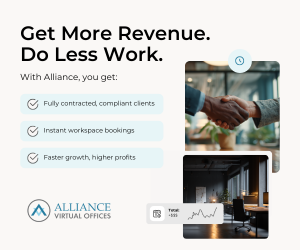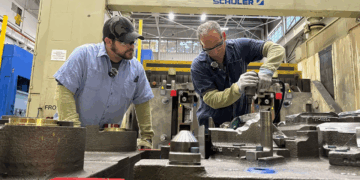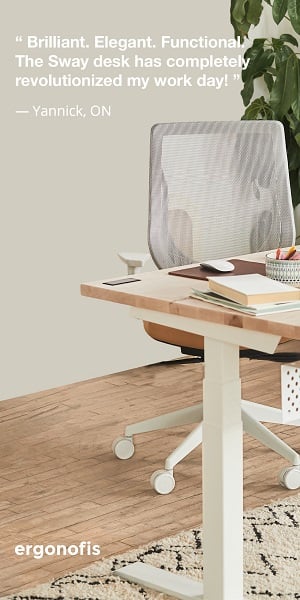- As VP of Global Research at MillerKnoll, Anderson advocates for converting office buildings into mixed-use spaces (e.g., housing, community hubs) to create stronger, more connected urban communities.
- Anderson stresses the importance of coordinated hybrid work models, where office spaces are designed to meet both productivity and social connection needs, ensuring employees can easily collaborate.
- Anderson’s vision for the future of work is one where spaces are designed to support relationships and a sense of community.
This article is based on the Allwork.Space Future of Work Podcast episode featuring Ryan Anderson, VP of Global Research and Insights at MillerKnoll. Click here to listen to the full episode.
When it comes to identifying trends and key priorities in office design, there may be no one more knowledgeable than Ryan Anderson, VP of Global Research and Insights at MillerKnoll.
He recently shared with Allwork.Space how workspaces can better prioritize community, comfort, and connection in the future of work — and why it’s a much better use of time than focusing solely on productivity metrics.
One of Anderson’s most intriguing points is the idea of mixed-use developments in cities like New York, where zoning laws could mandate both residential and commercial spaces in new buildings.
He suggested that, rather than building more office towers, cities could repurpose existing structures into vibrant, multi-functional spaces. For example, office buildings could be converted into student housing, co-living spaces for seniors, or even community hubs.
Design can help combat loneliness
This change could not only rejuvenate urban centers but also help address the growing crisis of social isolation — especially as loneliness becomes an epidemic in the West.
By combining living and working spaces, people would be more connected, encouraging stronger communities and reducing the physical and emotional separation that technology often promotes.
Anderson also explored how technology, despite its benefits, is contributing to a more atomized, individualistic experience of work.
Many of the tools we use — whether for video calls or solo activities like streaming — encourage isolation.
He pointed out that many of the tools we use — whether for video calls or solo activities like streaming — encourage isolation.
The challenge now is how to design workspaces that actively promote face-to-face connections.
He coined the concept of “relationship-based work,” emphasizing the need to design spaces that support both the strong ties we have with close colleagues and the weaker, more distant ties with others across the organization.
These weak ties, while less frequent, are crucial for a sense of belonging and community at work.
He also highlighted the critical role of place attachment — a concept from social science that explains how our emotional connection to physical spaces can influence our well-being and productivity.
Workplaces should offer a balance between areas for focused work and spaces that encourage casual interactions with colleagues, from cafes to event areas. These informal settings can be crucial for strengthening weak ties and ensuring employees feel connected to the larger purpose of the organization.
Hybrid work models can support community and belonging
On the topic of hybrid work, Anderson stressed that flexibility should be paired with coordination. He pointed out that the current hybrid model often leads to disorganization, with employees unsure whether the colleagues they hope to connect with will actually be in the office.
A more structured approach is necessary to make hybrid work successful — offices should provide employees with the ability to choose spaces based on their needs for the day, whether for deep work or socializing with people they don’t regularly interact with.
Anderson’s vision for the future of work is one where spaces are designed to support relationships and a sense of community.
Ultimately, Anderson’s vision for the future of work is one where spaces are designed to support relationships and a sense of community.
By blending residential and workspaces, encouraging face-to-face interaction, and creating environments that promote both personal productivity and social connection, organizations can better support the needs of today’s workforce.
Anderson further explored the idea that office design should empower employees to achieve goals collectively, not just supervise or express hierarchy.
He pointed to the need for cross-pollination between different types of spaces — offices, homes, schools, and hospitals — and how learning from one environment can inform design in another.
Ergonomics is important for worker comfort…but it’s not just physical
Comfort, he argued, goes beyond physical ergonomics to include emotional and cognitive comfort.
People gravitate toward spaces that offer a sense of ease, even if those spaces aren’t ergonomically ideal.
Anderson called for workplaces to better support both physical and emotional comfort, ensuring employees feel supported not just in their desk environments but across all spaces where work happens — whether at home, in cafes, or in collaborative areas.
This holistic approach to comfort is essential for improving employee well-being and productivity.
“If we understand that comfort is not just physical, but it’s also social, and there’s cognitive, mental comfort, etc…here’s reasons why we gravitate towards certain places,” Anderson said during a podcast conversation with Allwork.Space. “We’re in a situation right now where physical ergonomics is being neglected and employers are not paying near enough attention to it.”
Anderson noted that the origins of ergonomics were primarily about optimizing productivity, not comfort.
“The roots of ergonomics were around basically finding ways in manufacturing and other environments to accomplish tasks more quickly. It wasn’t really about comfort as much as it was eliminating barriers to productivity,” he explained.
He reflected on the philosophical idea of comfort, quoting Bill Stumpf, who created the first ergonomic chair, the Ergon for Herman Miller.
Stumpf often cited philosopher William Gass, who said, “Comfort is the absence of awareness.”
Anderson explained that this is the goal of good workplace design: creating environments where people can work without distractions — whether that distraction is a poorly designed chair or too much ambient noise.
Distributed work environments require good leadership
Anderson also spoke of the need for exceptional leadership in today’s hybrid, distributed work environment.
He emphasized that teams are the nucleus of organizational success.
“Most of our work life relates so directly with the abilities and temperament of our managers,” Anderson said, drawing attention to the need for organizations to invest in team leadership. This, he believes, is essential to managing the complexities of modern work dynamics.
“The world is only going to continue to get more distributed, and so organizations are going to have to spend more and more time training leaders,” he said.
Workers are on a quest for belonging and purpose
Lastly, Anderson spoke about the growing employee desire for purpose and belonging.
“There is a growing desire for a lot of people to work for an organization whose intent, even within the context of the business world, is good,” he said.
He believes this ties directly to employee retention and overall organizational success.
Companies that fail to create a sense of belonging or show genuine care for their employees’ well-being may struggle to maintain a competitive edge in today’s labor market.
Anderson made it clear that the future of work isn’t just about adapting to new technologies or redesigning office spaces — it’s about understanding the needs of employees on a deeper level and creating environments where they can thrive, both individually and collectively.
“Employees are the critical foundation for all this,” he concluded, underscoring that their well-being and sense of community will ultimately drive business success.


 Dr. Gleb Tsipursky – The Office Whisperer
Dr. Gleb Tsipursky – The Office Whisperer Nirit Cohen – WorkFutures
Nirit Cohen – WorkFutures Angela Howard – Culture Expert
Angela Howard – Culture Expert Drew Jones – Design & Innovation
Drew Jones – Design & Innovation Jonathan Price – CRE & Flex Expert
Jonathan Price – CRE & Flex Expert













